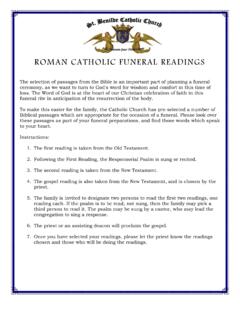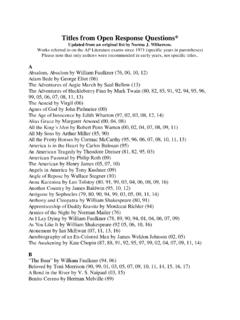Transcription of Lesson 9 the Sacrifice - absg.adventist.org
1 689 Jesus, the Perfect SacrificeSabbath afternoonRead for This Week s Study: Heb. 9:15, Gen. 15:6 21, Jer. 34:8 22, Eph. 3:14 19, Heb. 7:27, Heb. 10:10, Heb. 9:22 Text: For by one offering He has perfected forever those who are being sanctified (Hebrews 10:14, NKJV).The idea that a man found guilty and executed on a cross should be worshiped as God was offensive to the ancient mind. Sparse reference to the cross in Roman literature shows their aversion to the idea. For the Jews, the law declared that a man impaled on a tree was cursed by God (Deut.)
2 21:23).Thus, the first motifs that we find in the Christian paintings of the catacombs were the peacock (supposedly symbolizing immortality), a dove, the athlete s victory palm, and the fish. Later, other themes appeared: Noah s ark; Abraham sacrificing the ram instead of Isaac; Daniel in the lions den; Jonah being spit out by the fish; a shepherd carrying a lamb; or depictions of such miracles as the healing of the paralytic and the raising of Lazarus.
3 These were symbols of salvation, victory, and care. The cross, on the other hand, conveyed a sense of defeat and shame. Yet, it was the cross that became the emblem of Christianity. In fact, Paul simply called the gospel the word of the cross (1 Cor. 1:18, ESV).This week we will look at the cross as it appears in the book of Hebrews.* Study this week s Lesson to prepare for Sabbath, February 26.*February 19 25 Lesson69 February 20 Why Were Sacrifices Needed?Hebrews 9:15 explains that the death of Jesus as a Sacrifice had the purpose of providing redemption of the transgressions that were com-mitted under the first covenant, in order that the people of God might receive the promise of the eternal inheritance (NASB).
4 In the ancient Near East, a covenant between two persons or nations was a serious matter. It involved an exchange of promises under oath. It implied the assumption that the gods would punish those who broke the oath. Often, these covenants were ratified through the Sacrifice of an example, when God made a covenant with Abraham, the cere-mony involved cutting animals in half (Gen. 15:6 21). The parties would walk between the parts as an acknowledgment that those animals represented the fate of the party who broke the covenant.
5 Significantly, only God walked between the animals, for the purpose of communicat-ing to Abraham that He would not break His Genesis 15:6 21 and Jeremiah 34:8 22. What do these texts teach about the covenant? _____ _____The covenant with God gave Israel access to the Promised Land as their inheritance. It involved, however, a set of commandments and the sprinkling of blood upon an altar. This sprinkling implied the destiny of the party who broke the covenant. This is why Hebrews says that without the shedding of blood there is no remission [of sins] (Heb.)
6 9:22, literal translation).When Israel broke the covenant, God faced a painful dilemma. The covenant demanded the death of the transgressors, but God loved His people. If God should simply look the other way or refuse to punish the transgressors, His commandments would never be enforceable, and this world would descend into Son of God, however, offered Himself as a Substitute. He died in our place so that we may receive the promised eternal inheritance (Heb. 9:15, 26, ESV; Rom. 3:21 26). That is, He was going to uphold the sanctity of His law while at the same time saving those who broke that law.
7 And He could do this only through the can we see here why the law is so central to the gospel mes sage? _____sunday70 February 21 Diverse Kinds of SacrificesJesus death provided forgiveness, or remission, for our sins. The remission of our sins, however, involves much more than the cancel-lation of the penalty for our transgression of the covenant. It involves other elements just as important. That is why the Israelite sacrificial system had five different kinds of sacrifices. Each was necessary to express the richness of the meaning of the cross of Ephesians 3:14 19.
8 What was the prayer request of Paul in behalf of believers? _____ _____ _____ _____The holocaust offering (or burnt offering) required that the whole animal be consumed on the altar (Leviticus 1). It represented Jesus, whose life was consumed for us. Expiation required Jesus total com-mitment to us. Even though He was equal with God, Jesus emptied himself, by taking the form of a servant (Phil. 2:5 8, ESV).The grain offering was a gift of gratitude for God s provision of sustenance for His people (Leviticus 2).
9 It also represents Jesus, the bread of life (John 6:35, 48), through whom we have eternal peace or fellowship offering implied a communal meal with friends and family to celebrate the well-being provided by God (Leviticus 3). It represented Christ, whose Sacrifice provided peace for us (Isa. 53:5, Rom. 5:1, Eph. 2:14). It also emphasizes that we need to participate in Jesus Sacrifice by eating of His flesh and drinking of His blood (John 6:51 56).The sin or purification offering provided expiation for sins (Lev.)
10 4:1 5:13). This Sacrifice emphasized the role of the blood of the animal which represented its life to provide redemption from sins (Lev. 17:11) and pointed forward to the blood of Jesus who redeems us from our sins (Matt. 26:28, Rom. 3:25, Heb. 9:14).The guilt or reparation offering (Lev. 5:14 6:7) provided forgiveness in cases where reparation or restitution was possible. It tells us that God s forgiveness does not free us from the responsibility to provide reparation or restitution, where possible, to those whom we have sanctuary sacrifices teach us that the experience of salvation is more than just accepting Jesus as our Substitute.













